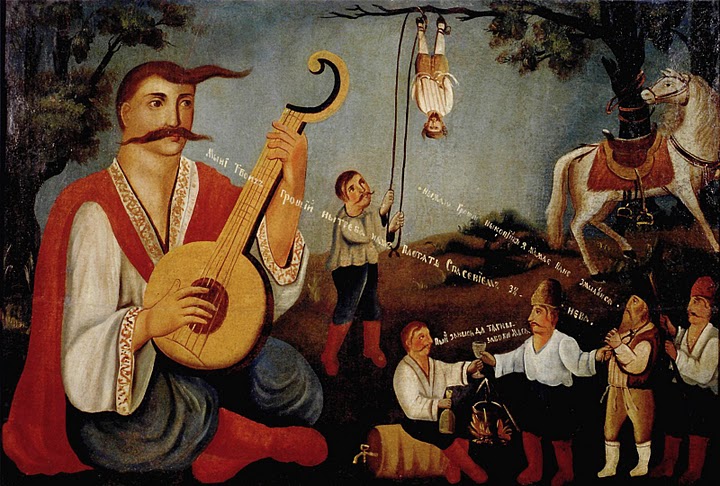The term “cossacks” is used to describe a class of 17th century Ukrainians, largely peasants, who separated from the burdens of traditional peasant life to form rebel communities at the furthest reaches of Polish-controlled territory. Ukrainians view them as exemplars of their unique national spirit: heroic, non-conformist, and fiercely independent, defending Ukrainian national sovereignty from all enemies. But for Jews, Cossacks are symbols of fear and hatred, the perpetrators of centuries of brutal pogroms.
The Ukrainian term kozak is derived from the Turkic word kazak, meaning “free man.” Living on the fringe of the Polish-Lithuanian Commonwealth, the Cossacks developed communities that valued freedom above all else and owed allegiance to no political power. They launched frequent raids on neighboring Tatar communities, sometimes to rescue captives from the slave traders, and attacked Polish authorities in at least eight smaller but bloody conflicts before the middle of the 17th century. With their characteristic kokhol-style partially shaved heads, walrus mustaches and baggy pants, they created an iconic image of the Ukrainian spirit, refusing to bow before any authority.
The Cossacks were unified in the middle of the 17th century by Bohdan Khmelnytsky, a military commander who launched a major attack against three enemies: Polish landowners controlling Ukrainian territories, Ukrainians who had abandoned Orthodox Christianity to join the Roman Catholic church — and Jews. Of the three, Polish landowners were furthest away to the north, followed by Ukrainian Catholics concentrated in the western reaches of what is today Ukraine. But Jews were right at hand, and consequently suffered brutal attacks in Khmelnytsky’s war between 1648-49.
Why the Jews? They occupied an especially unfortunate position in the triangular economy of Poles, Ukrainians, and Jews. Although a small Jewish presence in Ukraine dated back centuries, a growing number of western European Jews had been migrating there since the 13th century, fleeing antisemitic pressures like the Blood Libel and numerous expulsions. The Polish-Lithuanian Commonwealth represented new opportunities for Jewish migrants, many of whom came with vital skills of literacy and numeracy, because the Polish nobility owned huge tracts of land in Ukraine and they needed able administrators to manage the properties.
With your help, My Jewish Learning can provide endless opportunities for learning, connection and discovery.

Jews wound up serving as leaseholders in an arrangement called the arenda, essentially a kind of tax farming. Polish noblemen would negotiate a price for the lease of entire agrarian communities and whatever taxes the Jewish leaseholders could collect above and beyond that amount would constitute their salaries. The system was prone to exploitation. If Jewish leaseholders met their yearly tax without difficulty, the Polish nobleman could easily raise the demand for the following year, and the Jewish leaseholders would have to pass the increased costs onto the Ukrainian peasants. An expanding number of other charges were gradually imposed on the peasantry, everything from a fishing tax to a Jewish monopoly on the distillation and sale of alcoholic beverages.
An influential 17th-century account, the Eyewitness Chronicle, describes the widespread attitude to the Jewish role in the economy: “meanwhile the lazy scoundrel, the lazy Jew, grew richer, riding a carriage drawn by several pairs of horses and thinking up new taxes: the ox tax, the handmill tax, the measuring tax, the marriage tax and others.” Most notoriously, many early accounts emphasized the charge that Jewish leaseholders controlled the keys to Orthodox churches.
Jewish-authored chronicles from the period, most notably Nathan of Hannover’s Abyss of Despair, portray the Jewish role in the Ukrainian economy with far more sympathy. But the gradual impoverishment of Ukrainians through exploitative taxation was not denied, a phenomenon that historian Gershom Bacon called “guilty with an explanation,” emphasizing that Jews were largely helpless to contradict the demands of the Polish nobility. Regardless, entire Jewish communities were held responsible and suffered horribly when the Cossacks rebelled against Poland.
Ukrainians and Jews continue to see the Cossacks, and especially Khmelnytsky, in exceptionally different ways. For Ukrainians, he is regarded as a seminal figure who led a popular uprising that successfully threw off the Polish yoke. Khmelnytsky is to this day featured on the Ukrainian currency and celebrated with a massive statue in central Kyiv. Jews, on the other hand, remember him as “Chmiel the wicked,” leader of the worst pogroms since the Crusades.
The possibility of an alignment between these two historical narratives is not very likely. Even though the events of the uprising are nearly 400 years distant, the competing memories of that era are firmly established in both the Ukrainian and Jewish self-conception. Nevertheless, developments of the post-Soviet era suggest that a historical reevaluation of the Cossacks is not out of the question. In the Russian-Ukrainan war of 2022, Volodymyr Zelensky, the Ukrainian Jew elected president in 2019 in a landslide, regularly awarded soldiers the coveted Order of Bohdan Khmelnytsky medal for bravery. Watching a Jewish president hand out a medal named for a Cossack leader to a heroic defender of a multicultural Ukrainian state suggests that perhaps a historical reconciliation might someday be possible.
!['The Cossacks' Reply to the Sultan (Zaporozhtsy)', c1890, (1939). 'Reply of the Zaporozhian Cossacks to Sultan Mehmed IV of Turkey', also known as 'Cossacks of Saporog Are Drafting a Manifesto', 19th-century imagining of a supposed historical event of 1676, based on the legend of Cossacks sending an apparently rude and insulting reply to an ultimatum from Sultan Mehmed IV of the Ottoman Empire. 'On the right is Taras Bulba (in a white cap), the hero of Gogol's tale of the same name; on the left is Andrei, Taras Bulba's son; almost in the centre sits Ataman (Chief) Serko with a pipe in his mouth'. Ilya Repin (1844-1930) took nearly 20 years to paint the picture, for which Tsar Alexander III paid him 35,000 rubles, at the time the greatest sum ever paid for a Russian painting. In the collection of The State Russian Museum, St Petersburg, Russia. From "The Russian State Museum". [State Art Publishers, Moscow and Leningrad, 1939]](https://www.myjewishlearning.com/wp-content/uploads/2022/03/GettyImages-1085305746-1390x900.jpg)


